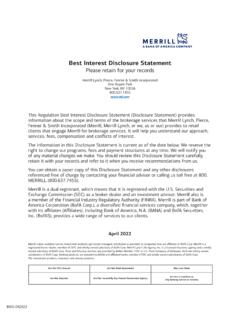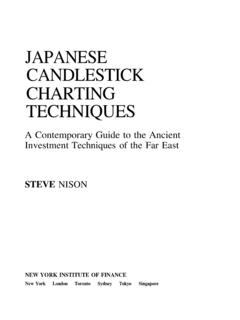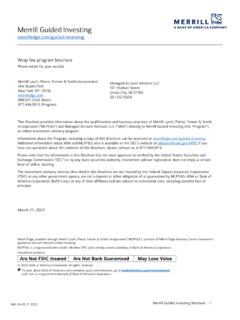Transcription of Japanese Candlestick Charting Techniques
1 Japanese Candlestick Charting Techniques ~-Y?~L&B~E!% L?ABWt "Candles Exhaust Themselves to Give Light to Men" Japanese Candlestick Charting Techniques A Contemporary Guide to the Ancient Investment Techniques of the Far East STEVE NISON NEW YORK INSTITUTE OF FINANCE NewYork London Toronto Sydney Tokyo Singapore Library of Congress Cataloging-in-Publication Data Nison, Steve. Japanese Candlestick Charting Techniques : a contemporary guide to the ancient investment technique of the Far East I Steve Nison. p. cm. Includes bibliographical references and index. ISBN 0-13-931650-7 1. Stocks-Charts, diagrams, etc. 2. Investment analysis. I. Title. 1991 90-22736 '22-dc20 CIP This publication is designed to provide accurate and authoritative infor- mation in regard to the subject matter covered.
2 It is sold with the understanding that the publisher is not engaged in rendering legal, accounting, or other professional service. If legal advice or other expert assistance is required, the services of a competent professional person should be sought. From a Declaration of Principles Jointly Adopted by a Committee of the American Bar Association and a Committee of Publishers and Associations 01991 by Steve Nison All rights reserved. No part of this book may be reproduced in any form or by any means without permission in writing from the pub- lisher. New York Institute of Finance Simon & Schuster Printed in the United States of America 10987 Acknowledgements Like having ice cream after a tonsillectomy, this section is my treat after the book's completion.
3 Some of those who deserve recognition for their help are addressed in Chapter 1 in my discussion of my Candlestick education. There are many others whom I would like to thank for their help along my candle- stick path. Candles might help light the way, but without the assistance and insights of many others it would have been almost impossible to do this book. There were so many who contributed in one way or another to this project that if I have forgotten to mention anyone I apologize for this oversight. The Market Technicians Association (MTA) deserves special mention. It was at the MTAfs library that I first discovered Candlestick material written in English. This material, albeit scant, was extremely difficult to obtain, but the marvelously complete MTA library had it.
4 This informa- tion provided the scaffolding for the rest of my Candlestick endeavors. Besides the two English references on candlesticks I mention in Chapter 1, I also obtained a wealth of information from books published in Japanese . I would like to thank the following Japanese publishers and authors for these books that I used as references: Kabushikisouba no Technical Bunseki (Stock Market Technical Analysis) by Gappo Ikutaro, published by Nihon Keizai Shinbunsha Kabuka Chato no Tashikana Yomikata (A Sure Way to Read Stock Charts) by Katsutoshi Ishii, published by Jiyukokuminsha Keisen Kyoshitsu Part 1 (Chart Classroom Part I), published by Toshi Rader Hajimete Kabuka Chato wo Yomu Hito no Hon (A Book for Those Reading Stock Charts for the First Time) by Kazutaka Hoshii, published by Asukash- uppansha vi Acknowledgements Nihon Keisenshi (The History of Japanese Charts), Chapter 2 by Kenji Oyama, published by Nihon Keisai Shimbunsha Shinpan Jissen Kabushiki Chart Nyumon (Introduction to Stock Charts)
5 By Okasan Keisai Kenkyusho, published by Diamond-sha Sakata Goho Wa Furinkazan (Sakata's Five Rules are Wind, Forest, Fire and Mountain), published by Nihon Shoken Shimbunsha Yoshimi Toshihiko no Chato Kyoshitsu (Toshihiko Yoshimi's Chart Classroom) by Toshihiko Yoshimi, published by Nihon Chart Then there's the team at merrill Lynch who were so helpful in look- ing over the manuscript, making suggestions, and providing ideas. John Gambino, one of the best colleagues anyone can work with provided all the Elliott Wave counts in this book. Chris Stewart, Manager of Futures Research, not only read the entire manuscript but provided valuable suggestions and finely dissected the many, many charts I used. I also want to thank Jack Kavanagh in compliance who also read the manu- script.
6 Yuko Song provided extra insights by conveying some of my can- dlestick questions to her Japanese customers who use candlesticks. I have included hundreds of charts in this book from various services. Before I thank all the services that have generously provided use of their Candlestick charts, I want to give plaudits to Bloomberg and CQG (Commodity Quote Graphics). Bloomberg was among the first on-line services to provide can- dlestick charts on the American markets. It's too bad I didn't discover this earlier. I was drawing Candlestick charts on my own for years before I found out about Bloomberg. CQG, an on-line futures Charting service, was also among the first to see the potential of Candlestick charts. Within a few weeks of my first Candlestick article, they sent me an alpha test (this is a high-tech term for the very early stages of software prototype testing) of their Candlestick software for my CQG System OneT".
7 Once I had this software, my Candlestick research progressed exponentially. Most of the charts in this book are courtesy of CQG. Besides Bloomberg and CQG, other services that were kind enough to provide charts are: Commodity Trend Service Charts (North Palm Beach, FL), CompuTracT" (New Orleans, LA), Ensign Software (Idaho Falls, ID), Future- SourceT" (Lombard, Ill), and Quick 10-E Financial Information System (New York, ). I want to thank those who took time from their busy schedules to review the introductions for Part Two of the book. These are: Dan -- - Acknowledgements vii Gramza for the chapter on Market Profile@; Jeff Korzenik for the chapters on options and hedging; John Murphy for the chapter on volume and open interest; once again, John Gambino for the chapter on Elliott Wave; Charles LeBeau for the chapter on oscillators; Gerard Sanfilippo and Judy Ganes for the chapter on hedging; and Bruce Kamich for the English language glossary.
8 The Nippon Technical Analysts Association (NTAA) deserves utmost praise for their assistance. Mr. Kojiiro Watanabe at the Tokyo Investment Information Center helped me to contact NTAA members who have been especially helpful. They are: Mr. Minoru Eda, Manager, Quantative Research, Kokusai Securities Co.; Mr. Yasushi Hayashi, Senior Foreign Exchange Trader at Sumitomo Life Insurance; and Mr. Nori Hayashi, Senior Analyst, Fidelity Management and Research (Far East). When I asked them questions via fax I expected just brief answers. But these three NTAA members took their valuable time to write pages of explana- tions, complete with drawings. They were wonderful about sharing their Candlestick experiences and insights with me. I also want to thank them for reading over and providing information for Chapter 2 on the history of Japanese technical analysis.
9 If there are any mistakes that remain, they are those that I failed to correct. I want to thank again "idea a day" Bruce Kamich. Bruce is a friend and a fellow futures technician. Throughout our 15-year friendship he has provided me with many valuable ideas and suggestions. Probably two of the most important were his suggestion that I join the MTA and his constant haranguing until I agreed to write a book about candle- sticks. Then there's the publishing staff of the New York Institute of Finance. They were all great, but those with whom I worked most closely deserve extra praise. Susan Barry and Sheck Cho patiently, skill- fully and affably guided a neophyte author through the labyrinth of the book publishing business. Of course there is my family.
10 At the time that I was writing this book, our newborn son Evan entered the picture (with all the excitement about candlesticks, I came close to calling him Candlesticks Nison). Try writing a book with a newborn and a rambunctious four-year-old daughter, Rebec- ca, and you start to get an idea of how much my wife, Bonnie, contributed to this book. She cared for the children while I maladroitly pummeled away at the keyboard. Obviously, she had the harder job. For each chapter's heading, and throughout the book, I used Japa- nese proverbs or sayings. Many times proverbs in the United States are considered trite and are rarely used. This is not so in Japan where prov- erbs are respected. Besides being enjoyable to read, the Japanese prov- erbs offer insights into Japanese beliefs and perspectives.









